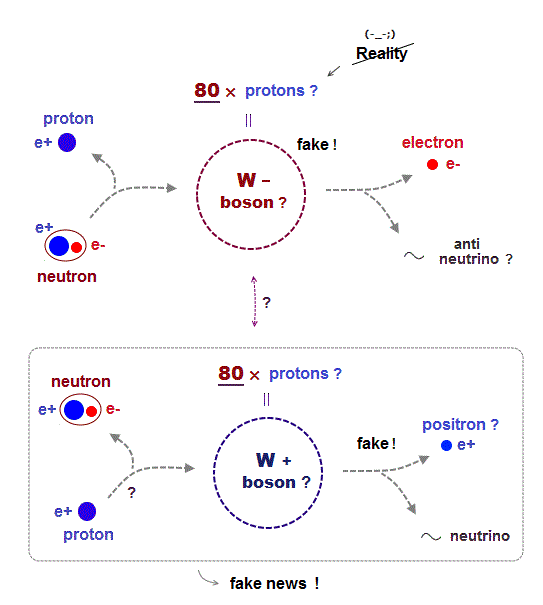
In nuclear fusion, two atomic nuclei form a new nucleus which generates an enormous amount of energy such as hydrogen bomb.
On the other hand, we need a clean and safe form of nuclear power.
Nuclear fusion is indispensable for the future of human beings.
Resources on the earth is very limited. Helium shortage is also one of serious problems, which can be solved by nuclear fusion, too.
In the present nuclear fusion, they try to fuse two positive hydrogen nuclei into one nucleus at extremely high temperature.
This conventional method is impractical. Because strong Coulomb repulsion between two positive nuclei hampers nuclear fusion.
To realize efficient nuclear fusion, we have to reconsider strange strong force under the present fictional quantum physics.
Fusing two positive nuclei is extremely difficult. On the other hand, an electrically neutral neutron can easily fuse with other nuclei.
Neutron is known to decay into an electron and a proton.
So neutral neutron = negaive electron + positive proton.
The present standard model claims the nuclear strong force is much stronger than electric Coulomb force.
But two protons cannot fuse into one nucleus overcoming their Coulomb repulsion. And two neutrons cannot fuse, either.
Only a pair of a neutron and a proton is possible (= deuterium ).
The present strong force based on quark and gluon cannot explain this reason !
It is known that a neutral neutron can easily fuse with other positive nuclei such as helium-3.
When a neutron and boron-10 fuse into boron-11, it generates new helium and lithium nuclei.
So a neutral neutron is a very promising particle to realize nuclear fusion.
It is known that an neutron easily decays into a proton and an electron in about 10 minutes. This neutron decay is very strange.
Because when an electron and a proton are very close to each other inside neutron, they attract each other by strong Coulomb force !
The reverse reaction ( electron + proton → neutron ) does NOT happen.
The present physics using virtual weak boson cannot explain it clearly.
de Broglie wavelength was experimentally proved, and used in quantization of hydrogen energy levels. Schrodinger equation is not an exception.
We can naturally think an integer times de Broglie wavelength rule prevents a neutron being formed from an electron and a proton.
When electron's orbit is an integer times de Broglie wavelength, it's stable and hard to decay, because its wave phase ends fit each other perfectly.
If this stable de Broglie wave phase prevents a neutron being formed, we need to cancel those de Brolgie waves !
If we can cancel the electron de Broglie wave, an electron is easily attracted to a proton by Coulomb force and makes a neutron.
Actually, an electron can be captured by nuclei under some special conditions where its de Broglie wave may be canceled by some nuclear signals.
To carry out this method, we have to know precise period and timing of an electron's motion using realistic model.
(Fig.8) ↓ Those virtual particles don't exist in "real" world.

They claim that standard model is very successful theory and agrees with every experiment (← ? ). But this claim is a big lie.
Because its forces are virtual, which is not real particle.
Its strong force, quark = fractional change cannot be isolated.
The most important force in standard model is "weak force" mediating beta decay.
But unfortunately, this weak (= W ) boson also lacks reality.
Because this W particle disobeys energy (= mass ) conservation.
(Fig.9) ↓ This heavy W boson violates conservation.
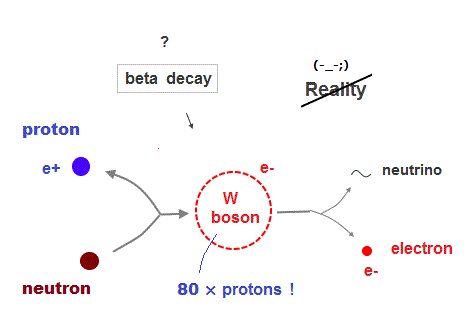
The problem is W boson, which they claim mediates this beta decay, is 80 times heavier than a proton !
This is very strange. Because they claim an initial neutron decays into a proton (+) and very heavy W boson (-).
As I said, the mass difference between a neutron and a proton is very small, which can never reach "80 times proton" mass !
So they start to claim this very heavy W boson is virtual (= not real ), which can appear for only a very short time.
This "far-fetched" interpretation is too good to be true.
Even in Higgs decay, this W boson is virtual, lacking realtiy.
So it's impossible to say the standard model "giving up reality" is the most successful theory. ( ← Big lie ! )
The present nuclear physics claims that a proton and a neutron consist of fractional-charge quarks.
But neither quarks nor gluons mediating strong force can be isolated, so these quarks are unreal particles.
They made a poor excuse that quark confinement is the reason fractional-charges are not found. ← Too good to be true.
As long as we rely on this unrealistic quark model in proton and neutron, realizing neuclear fuction is impossible.
It is known that hydrogen-3 (= tritium ) decays into helium-3 through beta decay. This process proves an electron is also an important component of nuclei !
On the other hand, fractional charges quarks never come out of nuclei !
So we must discard unrealistic quark model as soon as possible.
It's impossible to fuse two positive protons. An electron inside neutron is indispensable for forming each nucleus.
So we need to put a negative electron just between two positive protons to cause nuclear fusion instead of colliding positive nuclei by force !
A proton is very small, its radius is about 0.87 × 10-15 meter.
Radius of hydrogen atom is 5 × 10-11 meter and its Coulomb energy is 13.6 eV.
So when the distance between an electron and a proton is about short proton's radius, its Coulomb attractive energy becomes very big (= 1 MeV ) !
This magnitude can explain very strong nuclear binding energy.
This means nuclear strong force is caused by short-distance Coulomb attraction !
(Fig.14) Strong nuclear force is due to short-distance Coulomb attraction !
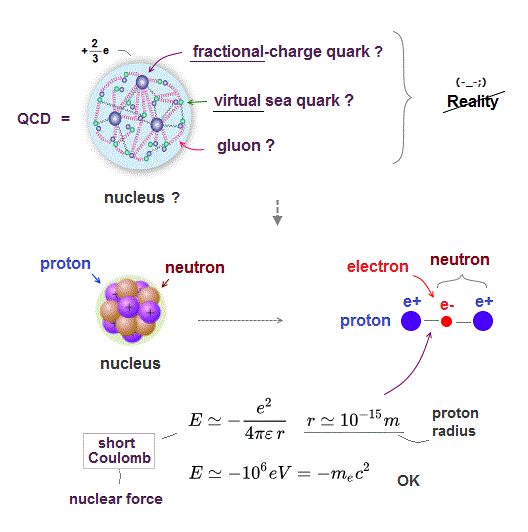
Standard model claims that strong nuclear force binding positive protons inside nuclei is caused by quarks and gluon.
But neither quarks nor gluons can be isolated, so these are only hypothetical.
It is known that all nuclei are composed of protons and neutrons.
The point is, neutrons (= proton + electron ) are indispensable for making each nucleus.
A electron inside neutron is thought to be binding protons by a very "short-distance" Coulomb force.
When an electron is between two protons, total Coulomb potential energy becomes negative, and stable.
In nuclei, these distances are very short, so Coulomb attraction is very Big, which explains strong nuclear force, NOT using "fantasy" quark !
(Fig.15) Nuclear structures in Deuterium and Helium-4.
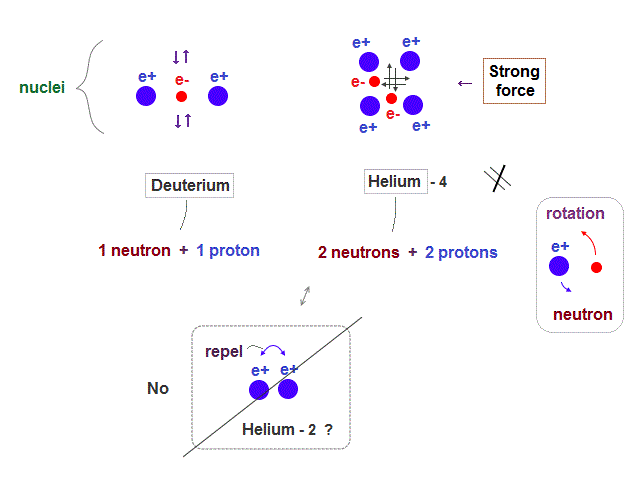
Deuterium has one proton and one neutron.
So it is thought that an electron ( inside neutron ) attracts two protons between them.
In the same way, helium-4 having two protons and two neutrons uses two electrons as a "binder". Nuclear space is very small, so each electron is quivering between protons.
In neutron, an electron tends to rotate around only one proton. This orbit tends to be an integer times de Broglie wavelength, breaking a neutron.
More than one protons are indispensable for electron's oscillations among protons.
Like "spring" motion, this oscillation conserves Coulomb energies between electrons and protons and makes their binding stable.
(Fig.16) β+ decay = positron emittion is inconsistent.
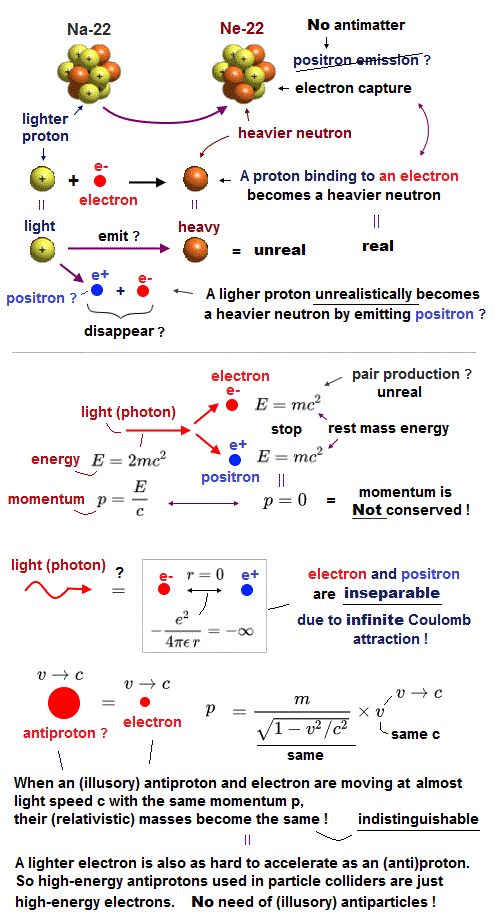
Neutron is slightly heavier than a proton, so neutron can decay into a proton and an electron by β decay.
Strange to say, the present physics claims that a proton can decay into a heavier neutron and a positron through positron emission.
Though a neutron is heavier than a proton, this positron emission process violates energy conservation law !
They say some "energy" inside nuclei can produce a positron and a heavier neutron from a proton. But this logic is impossible.
Because the "energy" itself such as light, kinetic energies .. is electrically neutral, which cannot produce a positive positron !
So a positive proton has to split into a positron and a "stable neutral thing" different from a neutron. But this "stable neutral things" have not been found so far.
As the second way, some light energy inside nuclei generates an electron and a positron through pair production, and only a positron is ejected from the nuclei ?
But in this case, the initial light is naturally emitted from the nuclei as it is, without causing the pair production. So the positron emission doesn't happen.
(Fig.18) ↓ Cloud chamber cannot measure the particle's velocity.
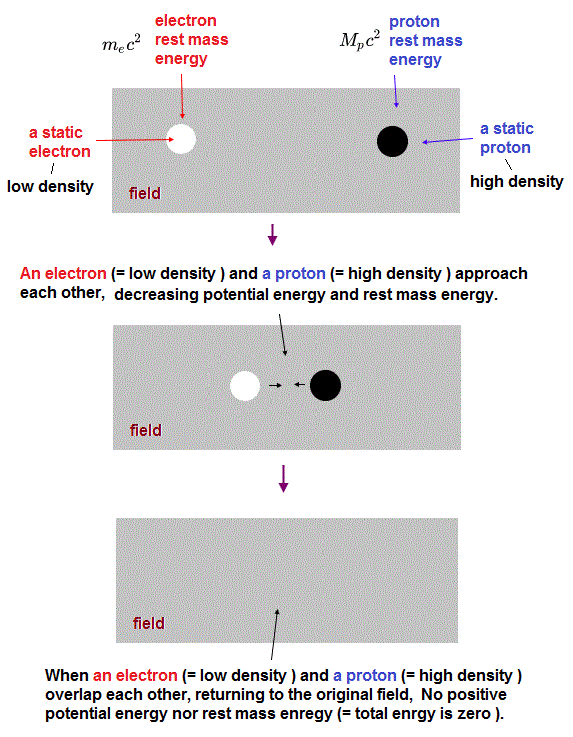
It is said that Anderson first discovered a positron using cloud chamber.
But in fact, this positron is a proton or a scattered electron.
Because the cloud chamber cannot distinguish between positron and proton ! To distinguish them, we need to know both particle's momentum (= curve ) and its velocity.
By just looking at the particle's track inside cloud chamber, we can know only particle's momentum, NOT its velocity.
Physicists apply magnetic field to charged particles to identify them.
The charged particle moves in the circular orbit due to Lorentz magnetic force.
The radius of this circular trajectory is related only to the particle's momentum (= mv ). So we cannot know the particle's mass (= m ) !
To distinguish a positron from a proton, we need to know the particle's velocity (= v ), which cannot be measured in this cloud chamber.
Basically heavier proton can move longer than a light positron when they have the same energy, because proton has larger momentum.
As shown in Millikan's oil drop experiment, it is impossible to measure the mass of very unstable positron.
(Fig.20) ↓Positron emission is impossible.
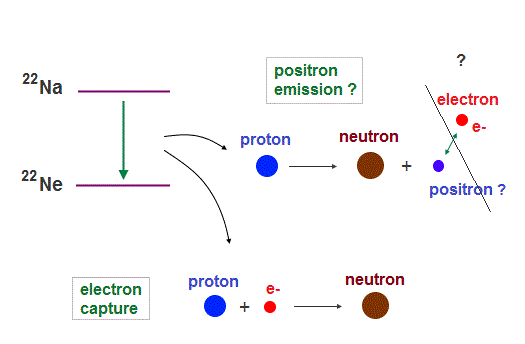
They say antimatter is useful (← ? ) as PET in hospital.
The point is they do not detect antimatter but emitted electromagnetic wave.
In fact, "positron emission" in PET can be replaced by real "electron capture", because they both have the same effect on a nucleus ( this p.3 ) !
In Na nuclide, they argue both positron ( β+ ) emission and electron capture produce the same Ne. ← Emitted "light" energy is the same, indistinguishable.
Positron emission is unrealistic, because a proton decays into a heavier neutron, causing "fantasy" perpetual machine !
So real "electron capture" is what actually happens in PET instead of unreal "positron emission". = antimatter is useless.
(Fig.21) Light → positron + electron at rest ?
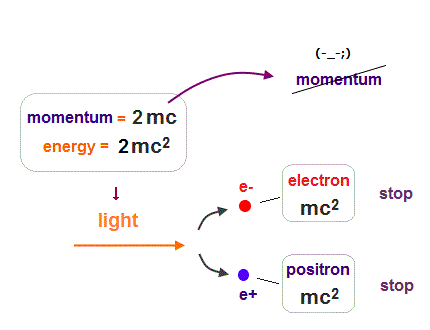
It is said antimatter can be produced from high energy light (= γ ray ). But we cannot generate it only from light !
They claim collision between accelerated electrons and nuclei is needed to generate antimatter. Light involved in antimatter is vitual photon.
So "antimatter is produced from high enegy (real) γ ray" is misleading.
Furthermore, antimatter disobeys energy and momentum conservation !
When a light (= energy 2mc2 ) produces a pair of positron and electron at rest, the initial light momentum is gone, because the resultant pair is stationary.
The incident light always has momentum (= p ). But after the light spends all its energy in producing a pair particles at rest, the initial momentum is missing !
Collisions among electrons and nuclei generate a large number of unrelated particles. We cannot measure the trajectry of each particle independently in magnetic.
So, random Coulomb scattering in infinite unrelated particles is one of main reason they misinterpret unrelated ones as imaginary antimatters.
(Fig.22) ↓ Much more energy than 2mc2 is needed ?
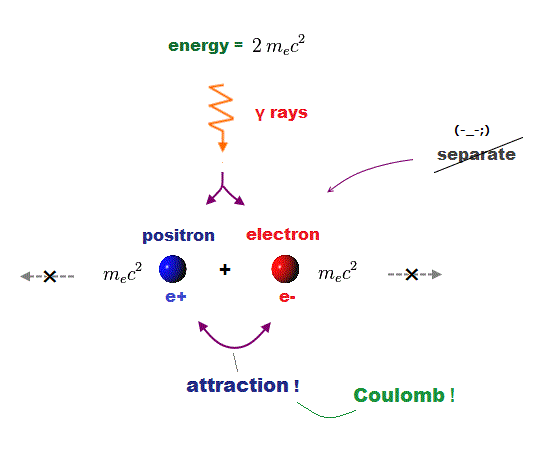
It is said that when the insident light (= γ rays ) energy is greater than 2mc2, it can generate an electron and a positron.
mc2 is electron's ( or positron ) rest mass energy. But the distance between the positron and electron is so short that their Coulomb attraction is very strong.
Separating them needs almost infinite energy, so impossible. Due to this Coulomb energy, the energy conservation is violated ( 2mc2 - Coulomb ).
Light and electron have different energy-momentum ratio.
So it's impossible that the light pushes and separate a positron from an electron.
(Fig.23) Two γ lights → positron + electron is impossible.
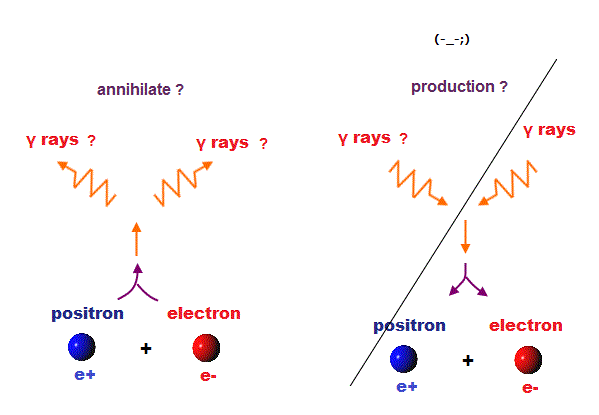
They say when a positron and an electron collide, they are annihilated to cause two γ ray light. Then its inverse reaction is possible ?
A positron can be produced when two γ lights collide ? In fact, this inverse pair production from light has NOT be confirmed !
So now, physicists try to generate antiparticles by colliding particle with some target metals, which makes it impossible to distinguish antiparticle from other unrelated ones.
Basically, all reactions including photon-photon colliders use virtual (= not real ) photons. Two real photons' collision is called Breit-Wheeler pair production.
This reaction of two "real" photons → positron + electron has never been observed. This ( p.3 ) uses collisions between electrons and light.
So as long as we cannot make antiparticles only from light, the existence of antiparticle is very doubtful.
(Fig.24) Antiparticle is always accompanied by virtual particle.
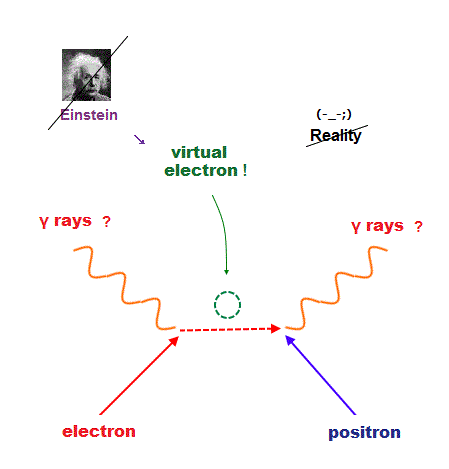
In the present physics, all reactions must be expressed by abstract Feynman diagram, which always includes virtual particles violating Einstein relativity.
Also when an electron and a positron change into two γ lights, this process must include "virtual electron" ( this Example 7 ).
This vitual particle contradicts Einstein relativity, so all antiparticle reactions accompanied by this virtual particle are unreal.
(Fig.25) Fermilab just applies magnetic field to separate ±ions.
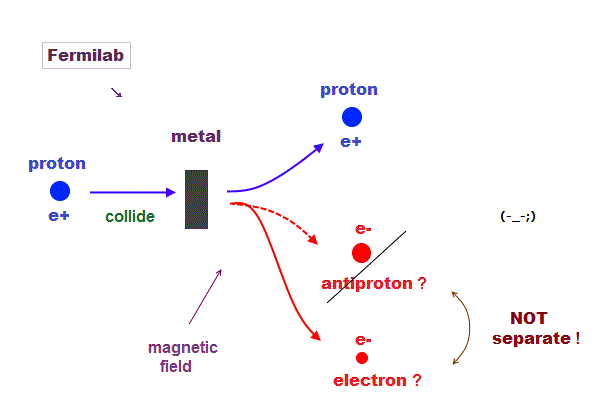
Antiprotons are said to be produced in particle colliders such as Fermilab.
But in fact, this negative antiproton is just an electron or other negative ions.
In Femilab, they accelerate protons, and collide them with some target metal.
After that, they just apply magnetic field with cannot distinguish antiproton from other negative particles (= electron ).
So antiprotons generated inside collider is just high-energy electrons or other negative ions. It's impossible to separate them !
In the same say, positron in other colliders is just proton or positive ions, because they just apply magnetic field ( this p.16 ).
(Fig.26) They "neglect" multi-particle Coulomb scattering.
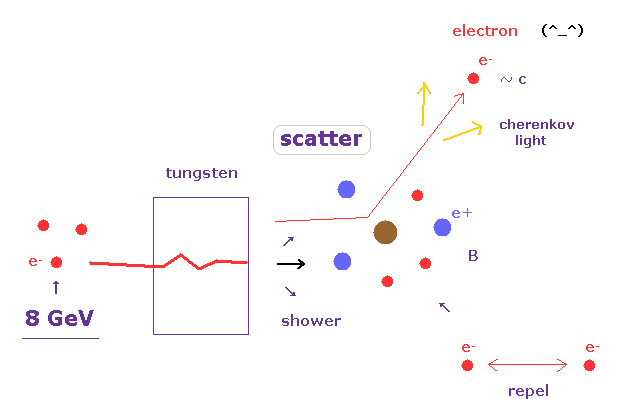
They try to generate antiparticles by colliding accelerated electrons ( or protons ) with some target metals, which produce many unrelated ions.
Even if we apply magnetic field, we cannot distinguish positron from other positive ions.
Coulomb scattering among infinite particles is much stronger, and cancels the magnetic force. So scattered electrons are easily mistaken for positrons.
Scintillators detecting γ lights cannot measure light frequency. They must convert high energy light into "visible light".
Scattered γ rays and electrons are likely to be mistaken for positron annihilation, because total energies inside devices are conserved and detected as "fake" positron annihilation light.
(Fig.27) Big Bang is used as an imaginary target like quantum computer.
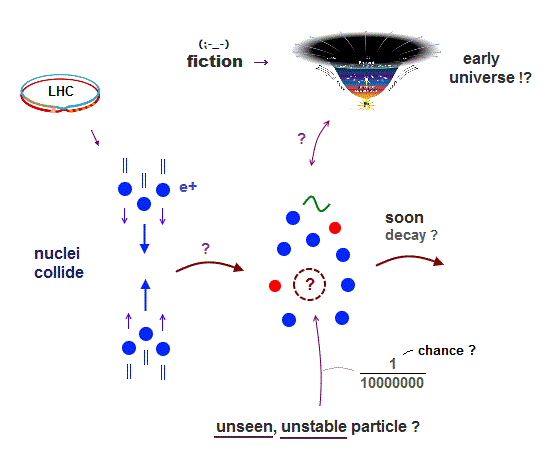
The present nuclear physics based on unreal quarks, antiparticles and virtual particles are useless and impractical, forever.
This is the reason they use fictional Big Bang as an imaginary target for useless nuclear physics ( this, this ).
This is similar to a "pie-in-the-sky" quantum computer.
(Fig.28) There is NO physical reason for antiparticle's existence.
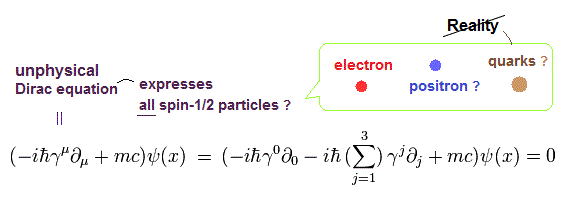
The only practical use (← ? ) of antiparticle is said to be PET.
But the positron emisstion in PET can be replaced by electron capture.
The initial and final products in positron emission and electron capture are completely the same ! Then why two different reactions are needed ?
It is very unnatural that our nature ( or God ) created two different mechanisms in the same reaction.
Furthermore antiparticles vanish and changes into light just after their generation ( lifetime is nanosecond ). So the existence of antiparticles is meaningless for us.
It is natural to think unstable and useless particles do NOT exist.

2016/4/1 updated. Feel free to link to this site.